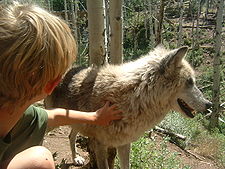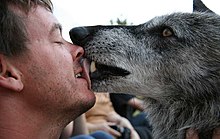Mission: Wolf
This article is written like a personal reflection, personal essay, or argumentative essay that states a Wikipedia editor's personal feelings or presents an original argument about a topic. (May 2017) |
This article needs additional citations for verification. (October 2008) |
| Mission: Wolf | |
|---|---|
Mission: Wolf logo | |
 Katimik, a former inhabitant (Now deceased) | |
 | |
| 37°57′48″N 105°12′54″W / 37.9632489°N 105.2148628°W | |
| Date opened | 1986 |
| Location | Westcliffe, Colorado, United States |
| Website | www.missionwolf.com |
Mission: Wolf (abbreviated M:W) is a remote wolf sanctuary near Westcliffe, Colorado. Housing up to 40 wolves and wolfdog crosses, Mission: Wolf works to promote a better understanding of wolves in order to further reintroduction efforts and discourage attempts to keep wolves as pets. People are welcome to visit and not only see the wolves up close, but have an opportunity to touch them as well. There is a nearby meadow where visitors can camp overnight. The 15 mi (24 km) of dirt road that climbs to 9,000 ft (2,700 m) is driveable in the summer (if not wet) by normal 2WD vehicles.
Founding
Mission: Wolf was founded by Kent Weber and his wife, Tracy, as a remote shelter for a dozen wolves and wolf-dogs. In the first year of constructing a house, they took in several wolf puppies. As word got out, visitors came and started to help the Webers build and work, and called themselves volunteers. With more people working, more fencing could be constructed and more wolves could be adopted.[1] In the peak of Mission: Wolf's adoption frenzy, they had 52 wolves and wolf-dogs, before they realized that they could not possibly accept every wolf.
Weber's goal is that there will be no more captive wolves. This is unlikely to happen in the foreseeable future. In addition, Weber aims to educate the public in general about the behavior of wolves, and to clear their reputation as 'The Big Bad Wolf.' He also is active in trying to dissuade people from breeding wolf-dogs and owning either wolves or wolf-dogs as pets.
Meeting the wolves

Often, several visitors come to Mission: Wolf daily for a tour. If they come at the right time, Kent may take them into one or more enclosures to meet the wolves personally. A Mission: Wolf staff will give you a brief safety orientation before you are able to enter an enclosure to greet a wolf. This orientation will cover what is appropriate to wear into the enclosure, how to properly greet a wolf, and to get you in the right mind set. The staff does not want to force anyone into doing something they are not comfortable doing and want to make sure that you have the right attitude before going into meet the wolves. Most importantly the staff wants to make sure that you have a great experience meeting the wolves and that you learn a thing or two about them in the process.
Mission: Wolf also tours America as a part of its Ambassador Wolf Program, traveling thousands of miles in their Wolfhound, a full-size Greyhound Bus that was converted to be able to house, minimally, two adults and two wolves, and assorted supplies.[2]

The Ambassador Program visits:[3]
- Government agencies-USFWS, NPS, NFS, BLM, USDA
- Conservation groups-Sierra, Audubon, Nat'l Wildlife Fed
- Universities-Harvard, Cornell, CU, ASU, UNM, UVM
- Schools-Private, Public, Disabled, Colleges, Preschools
- Clubs-Boy's & Girl's, 4-H, Scouts of America, Zoo's
- Museums, Nature Centers, Libraries, Law Firms, Corporations
- TV Specials that have included National Geographic, ABC, CBS, NBC, CNN, PBS, Mr. Rogers to the NBC Today Show, TV and Radio talk shows.
An example of topics discussed during the Wolf Programs include:
- Introduction to the world of Wolves and Hybrids
- Wild wolf issues; Rocky Mountains, Eastern, Mexican
- The Trophic Cascade; Lessons from Yellowstone National Park
- Captive wolf status, wolf hybrid ownership experiences
- Wolf communication and behavioral comparison to dogs
- Current status of wild wolves in North America
Volunteers
Many people make the journey to volunteer at Mission: Wolf each summer, and several stay two months or more to serve as staff. Staff usually receive a small stipend, and are provided meals and housing. They also have access to all electronics. There are several types of volunteers that attend Mission: Wolf each year:[4]
- Short Term Staff: Stay between 2 weeks and 1 month, sometimes campers that stay for more than a week become de facto volunteers.
- Long Term Staff: Stay between 1 month and 3 months, the main body of Mission: Wolf staff.
- Core Staff: Stay between 1 and 5 years, the more "administrative" staff of Mission: Wolf.
Resources
All the buildings at Mission: Wolf were built by volunteers and with donated materials. M:W is almost completely self-sufficient, using donations to pay for what they need, solar power on sunny days, and a propane generator when it is needed. Most ranchers in the area donate their livestock to the wolves when they die, giving the wolves a steady supply of feed.
Wolves

Mission: Wolf takes in only wolves who were born in captivity. Wolves that are born in captivity can never be returned to the wild, and thus, they live out their lives at Mission: Wolf. They prefer to take in only puppies, as full-grown wolves are very difficult work with if they haven't imprinted on the staff. As of July 15, 2008, 20 wolves and 5 wolf-dogs live at Mission: Wolf, with 2 more high dog content crosses being kept at Kent and Tracy's farm. Since founding, M:W has had to turn down over 9,000 requests to take in wolves and wolf-dogs.
Feeding
The wolves are all fed once a day, in what is called daily feed. This practice only began in summer 2008, and is mainly used as a vessel to provide vitamin supplements and medications to the wolves; before that, the wolves had only received the feast-and-famine cycle of two large meals a week, similar to their eating schedule in the wild. This is now called "big feed", and still occurs twice a week, though the wolves get slightly less food, as some is stored away for daily feed. Most often the donated livestock is horse meat, although turkeys, cattle, and roadkill deer are not unheard of.
References
- ^ Mission: Wolf Official Website: http://www.missionwolf.com/refuge_history.asp
- ^ Wolfhound
- ^ The Ambassador Wolf Program
- ^ "Volunteer at Mission: Wolf". Retrieved February 7, 2012.
